List of inscriptions in biblical archaeology
Appearance
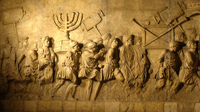




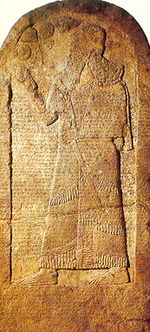
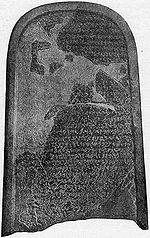

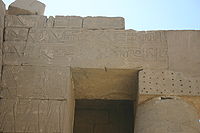




The following is a list of artifacts, objects created or modified by a human culture, that are significant to the historicity of the Bible.
Artifacts
- 10-line ritual cup (c. 1 AD) - 2,000-year-old limestone cup with 10 lines of Aramaic or Hebrew script found near the Zion Gate of the Old City of Jerusalem. Found by U.S. archaeologists; Shimon Gibson of the University of North Carolina at Charlotte stated that "To have 10 lines of text is unprecedented..." They know it contains the Hebrew word for God indicating it was probably important to the priests who used it in rituals.[3]
- Amarna letters (c. 1300s BC) - correspondence on clay tablets between the Egyptian administration and various Middle East kings petty sub-rulers in Canaan during the New Kingdom.
- Amman Citadel Inscription - 9th century BC inscription in the Ammonite language, one of the few surviving written records of Ammon.
- Arch of Titus - (c. 82 AD) relief shows spoils from the sack of Jerusalem by the Romans in 70 AD. Depicted are the menorah and trumpets, as well as what might be the Table of Showbread. (see: Judaea Capta coinage)
- Babylonian Chronicles (c. 747 BC - 247 BC) - dealing with Nebuchadnezzar's siege of Jerusalem, etc. (see Siege of Jerusalem (587 BC), Zedekiah and Book of Kings, Book of Jeremiah, Lamentations.)
- Balaam inscription (c. 840-760 BC) [4] 9th or 8th century BC inscription about a prophet named Balaam (cf. the Book of Numbers).[5]
- Biblical period ostraca (broken pottery used for writing brief notes, the ancient equivalent of notepaper) are relatively common in archaeological digs. One ostracon, found at Elah, may contain the earliest known example of Hebrew.
- The Black Obelisk of Shalmaneser III (c. 858-824 BC) - scholars believe the obelisk depicts either Jehu son of Omri (a king of Israel mentioned in 2 Kings), or Jehu's ambassador, paying homage to Assyrian king Shalmaneser III (c.825 BC); an early, possibly the earliest, surviving picture of an Israelite. The inscription identifies "the tribute of Jehu, son of Omri: I received from him silver, gold, a golden bowl, a golden vase with pointed bottom, golden tumblers, golden buckets, tin, a staff for a king [and] spears."
- Bubastis portal - showing a series of inscriptions recounting pharaoh Shishaq's invasion of Judah and Israel in 925 BC, located outside the Temple of Amun at Karnak.(1 Kings 14:25; 2 Chronicles 12:1–12).[6]
- Bullae (c.715 – 687 BC or 716 – 687 BC) [7] (clay roundels impressed with a personal seal identifying the owner of an object, the author of a document, etc) are, like ostraka, relatively common, both in digs and on the antiquities market. The identification of individuals named in bullae with equivalent names from the Bible is difficult, but identifications have been made with king Hezekiah [8] and his servants (עבדים avadim in Hebrew).
- Bulla of Jehucal - son of Shelemiah, son of Shevi. This person seems to be mentioned (twice) in the Book of Jeremiah who thus presumably lived in the late 7th century BC (i.e. at about the same time as Jeremiah). (see Large Stone Structure for discovery) (see also Book of Jeremiah).[9]
- Bulla of Shaphan (r. 609-598 BC.) - possible link to a figure during the reign of Jehoiakim.
- Bulla of Gedalyahu/Galihu Ben Immer - A bulla was excavated that contains part of a name Gabriel Barkay suggests may have been Galihu son of Immer, a brother of Pashur son of Immer, who is described in the Bible [Jeremiah 20:1] as a priest and temple official."[10][11]
- Cave of the Patriarchs - The compound, located in the ancient city of Hebron, is the second holiest site for Jews (after the Temple Mount in Jerusalem) and is also venerated by Christians and Muslims all of whom have some traditions which maintain that the site is the burial place of three Biblical couples: (1) Abraham and Sarah; (2) Isaac and Rebekah; (3) Jacob and Leah.
- Code of Hammurabi (1786BC) - a well-preserved ancient law code, created ca. 1790 BC (middle chronology) in ancient Babylon. It was enacted by the sixth Babylonian king, Hammurabi, and partial copies exist on a human-sized stone stele and various clay tablets.
- Cylinder of Cyrus (c. 559 BC-530 BC) - regarding King Cyrus's treatment of religion, which is significant to the books of Chronicles, Ezra and Nehemiah.
- Cylinder of Nabonidus (555-539 BC) - proves Belshazzar's existence. See Daniel 5; 7:1; 8:1. Daniel 5 describes Belshazzar's Feast where a hand was seen writing on the wall of the chamber a mysterious sentence mene mene tekel upharsin. (see also Nabonidus Chronicle)
- The Elephantine papyri, ancient Jewish papyri dating to the 5th century BC, name three persons mentioned in Nehemiah: Darius II, Sanballat the Horonite and Johanan the high priest.
- Deluge Tablet - The Epic of Gilgamesh records a Babylonian flood story (see: Noah).
- Ekron dedicatory inscription (7th century BC) - a dedicatory inscription of the seventh-century king of Ekron, Achish. Achish is a name used in the Hebrew Bible for two Philistine rulers of Gath. The inscription states "This temple was built by 'Akish, son of Padi, son of Yasid, son of Ada, son of Ya'ir, ruler of Ekron..." The inscription not only securely identifies the site, it gives a brief king-list of rulers of Ekron, fathers to sons: Ya'ir, Ada, Yasid, Padi, 'Akish.[12]
- Erastus Inscription
- Foundation Stone - stone also called the Well of Souls, now located in the Dome of the Rock. According to the Bible, King David purchased a threshing floor owned by Araunah the Jebusite,[13] and some believe that it was upon this rock that he offered the sacrifice mentioned in the verse. David wanted to construct a Temple in Jerusalem, but as his hands were "bloodied," he was forbidden to do so himself. The task was left to his son Solomon, who completed the Temple in c. 950 BC.
- Gezer calendar (10th century BC) - calendar from the Biblical city of Gezer. It is one of the oldest known examples of Hebrew writing.
- Goliath Potsherd (10th to mid 9th centuries BC) - Potsherd inscribed with the two names "alwt" and "wlt", etymologically related to the name Goliath. The artifacts are therefore connected with Tell es-Safi, the traditional identification of Gath.
- Hashmonean coinage
- Herodian architecture - Herodium
- Herod's temple
- Hezekiah's tunnel (c. 701 BC) - a tunnel created by King Hezekiah in anticipation of an Assyrian invasion. From National Geographic: "The tunnel, which is about 500 meters (550 yards) long, brings water from the Gihon Springs [sic], located some 300 meters (330 yards) outside the walls of old Jerusalem, to the Siloan Pool [sic] inside the ancient city. It was built to protect the city's water supply during an Assyrian siege".[14]
- Hittite texts
- Ipuwer Papyrus (c. 13th century BC) - ancient papyrus manuscript describing Egypt as afflicted by natural disasters and in a state of chaos. Statements such as "the River is blood" have been interpreted by some as an Egyptian account of the Plagues of Egypt described in the Book of Exodus in the Bible.[15][16]
- Jehoiachin's Rations Tablets (6th century BC) - date from the and describe the rations set aside for a royal captive identified with Jehoiachin, king of Judah (Cf. 2 Kings 24:12,15–6; 25:27–30; 2 Chronicles 36:9–10; Jeremiah 22:24–6; 29:2; 52:31–4; Ezekiel 17:12).[17]
- Jehohanan Crucifixion Nail (1st century AD) - Skeletal remains of crucified individual, showing a nail through the right calcaneus bone. It gives insight into the method of crucifixion used around the time of Jesus.[18]
- Judaea Capta coinage
- King Ahaz's Seal (732 to 716 BC) - Ahaz was a king of Judah but "did not do what was right in the sight of the Lord his God, as his ancestor David had done" (2 Kings 16:2; 2 Chronicles 28:1). He worshiped idols and followed pagan practices. "He even made his son pass through fire, according to the abominable practices of the nations" (2 Kings 16:3). Ahaz was the son and successor of Jotham.
- Khirbet Qeiyafa pottery sherd - (10th Century BC) early Hebrew inscription dates from the reign of King David and contains lines "similar to some Biblical scriptures, such as Isaiah 1:17, Psalms 72:3, and Exodus 23:3. Was discovered in excavations near Israel's Elah valley.[19]
- Kurkh Monolith (c. 859-824 BC) - names King Ahab of Israel, erected by Shalmaneser III to commemorate the Battle of Karkar, which Ahab participated in along with many other regional leaders.
- Lachish letters - letters written in carbon ink by Hoshaiah, a military officer stationed near Jerusalem, to Joash the commanding officer at Lachish during the last years of Jeremiah during Zedekiah’s reign (c.588 BC) (see Nehemiah 12:32, Jeremiah 42:1, 43:2). Lachish fell soon after, two years before the fall of Jerusalem.[20]
- Lachish relief - portion of the Sennacherib relief, which depicts captives from Judah being led into captivity after the fall of Lachish in 701 BC [21]
- Large Stone Structure - possible site of King David's palace.
- Law tablets - ancient Near East legal tablets: Code of Hammurabi, Laws of Eshnunna, the Code of Ur-Nammu, king of Ur (ca. 2050 BC), the Laws of Eshnunna (ca. 1930 BC) and the codex of Lipit-Ishtar of Isin (ca. 1870 BC).[22] Later codes than Hammurabi's include the Code of the Nesilim.[23] Hittite laws, the Assyrian laws, and Mosaic Law / Ten Commandments. (see Cuneiform law).
- List of New Testament papyri
- LMLK seals on storage jar handles, excavated from strata formed by Sennacherib's invasion during the reign of Hezekiah.[24][25]
- Melcarth/Ben-Hadad stele - William F. Albright identifies Bir-hadad with Ben-hadad I, who was a contemporary of the biblical Asa and Baasha.
- Merneptah Stele (c. 1209/1208 BC).- one of the earliest known references to Israel or to the Israelites.
- Mesha stele (also called the Moabite stone) (c.850 BC) - a Transjordan stele describing the victories of Moabite king Mesha over the Kingdom of Israel. French scholar André Lemaire suggested that line 31 of the Stele bears the phrase "the house of David" (in Biblical Archaeology Review [May/June 1994], pp. 30–37).
- Midianite pottery - The Biblical account states that Midian was where Moses spent the 40 years between the time that he fled Egypt after killing an Egyptian who had been beating a Hebrew,[26] and his return to lead the Israelites.[27] During those years, he married Zipporah, the daughter of Jethro, the priest of Midian. In later years the Midianites were often oppressive and hostile to the Israelites, at least partly as God's punishment for their idolatry.[28]
- Nabonidus Chronicle - Amélie Kuhrt describes it as "the most reliable and sober [ancient] account of the fall of Babylon."[29]
- Necho II basalt cartouche-found at Sidon, suggesting Necho II's involvement in the region (see: Josiah)
- Numbers amulets - Probably the oldest surviving texts currently known from the Hebrew Bible - Priestly blessing dated to 600 BC.[30] Text from the Book of Numbers in the Old Testament. Described as "one of most significant discoveries ever made" for biblical studies.[31][32]
- Nebo-Sarsekim Tablet - a clay cuneiform inscription referring to an official at the court of Nebuchadrezzar II, king of Babylon, possibly the same official named in the Biblical Jeremiah.[33]
- Neo-Assyrian military record
- Ostraca House - 64 legible ostraca found in the treasury of Ahab - written in early Hebrew.
- Pim weight - evidence of the use of an ancient source for the Book of Samuel due to the use of an archaic term.
- Seal of Jehucal - Jehucal or Jucal is mentioned in chapters 37 and 38 of the Book of Jeremiah where King Zedekiah sends Jehucal son of Shelemiah and the priest Zephaniah son of Maaseiah to the prophet Jeremiah saying `Please pray for us to the Lord our God` (Chapter 38 verse 3).
- Second Temple Inscription - inscription from Herod's Temple, late 1st century BC. It warns gentiles to refrain from entering the Temple enclosure, on pain of death.
- Second Temple Stone - A stone (2.43x1 meters) with Hebrew language inscription "To the Trumpeting Place" excavated by B. Mazar at the southern foot of the Temple Mount. It is believed that this was a part of the Second Temple.
- Sefire stele - described as "the best extrabiblical source for West Semitic traditions of covenantal blessings and curses."[34]
- Shebna's lintel inscription - found over the doorway of a tomb, has been ascribed to Hezekiah's comptroller Shebna.
- Shiphrah slave list - Shiphrah was one of two midwives who helped prevent the genocide of Hebrew children by the Egyptians, according to the Book of Exodus 1:15-21. The name is found in a list of slaves in Egypt during the reign of Sobekhotep III. This list is on Brooklyn 35.1446, a papyrus scroll kept in the Brooklyn Museum.
- Shishaq Relief - depicts Egypt's victory over King Rehoboam c. 925 BC, time of the plunder of Solomon's Temple in Judah.
- Siloam inscription - inscription records the construction of Hezekiah's tunnel in the 8th century BC .
- Stele of Zakkur - mentions Hazael king of Aram.
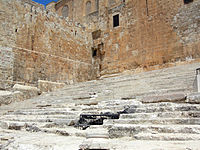
- Stepped Stone Structure - has been suggested as being Jebusite, the Millo, or part of the Large Stone Structure, which has been suggested as being part of King David's palace.
- Susa remains - Susa is mentioned in the Ketuvim of the Hebrew Bible, mainly in Esther, but also once each in Nehemiah and Daniel. Both Daniel and Nehemiah lived in Susa during the Babylonian captivity of Judah of the 6th century BC. Esther became queen there, and saved the Jews from genocide. A tomb presumed to be that of Daniel is located in the area, known as Shush-Daniel. The tomb is marked by an unusual white, stone cone, which is neither regular nor symmetric. Many scholars believe it was at one point a Star of David.
- Taylor Prism - a clay prism inscribed with the annals of the Assyrian king Sennacherib notable for describing his siege of Jerusalem in 701 BC during the reign of king Hezekiah. This event is recorded in several books contained in Bible including Isaiah chapters 33 and 36; 2 Kings 18:17; 2 Chronicles 32:9. This event is also recorded by Herodotus.
- Tel Dan Stele - a stele commemorating victory by Aramaeans against the Israelites. It is claimed by a number of scholars that the inscription contains the phrase House of David, although this translation has been disputed.
- Tombs - see Cave of the Patriarchs; Tomb of Daniel; Rachel's Tomb at Bethlehem;
- Ugaritic religious texts - verifies the account of Philo, preserved by Eusebius, regarding the Canaanite religion.
- Uzziah Tablet - controversial tablet discovered in 1931 by Professor E.L. Sukenik of the Hebrew University of Jerusalem in a Russian convent.
- Warren's Shaft - possible route corresponding to the biblical account of Joab, king David's commander, launching a secretive attack against the Jebusites, who controlled Jerusalem.
- Western Wall - is an important Jewish religious site located in the Old City of Jerusalem. Just over half the wall, including its 17 courses located below street level, dates from the end of the Second Temple period, being constructed around 19 BC by Herod the Great. The remaining layers were added from the 7th century onwards.
- Pool of Bethesda - in the nineteenth century, archaeologists discovered the remains of a pool exactly matching the description in John’s Gospel.
Popular controversies
- Acheiropoieta (see Shroud of Turin, Image of Edessa, and the Veil of Veronica)
- Ivory pomegranate
- James Ossuary
- Jehoash Inscription - controversial black stone tablet in Phoenician regarding King Jehoash's repair work. Suspected to be a forgery, (but see: Book of Kings).
- Shlomit / Temech seal
- Sudarium of Oviedo
- Tower of Siloam - ruins possibly mentioned in the Gospel of Luke.[35]
Artifacts described but unknown to modern scholarship
- The Ark of the Covenant
- Ephod
- Hoshen
- Noah's Ark - Searches for Noah's Ark
- Solomonic column - (see Boaz and Jachin)
Forgery
- Stone Seal of Manasseh - Stone seal of Manasseh, King of Judah c.687-642 BC. Reportedly offered to a private collector for one million dollars.[36]
Significant museums
People
- Austen Henry Layard - excavated Ninevah (later George Smith, Hormuzd Rassam)
- Robert Koldewey - excavated Babylon
- William F. Albright
See also

| Part of a series on the |
| Bible |
|---|
 |
|
Outline of Bible-related topics |
- Archaeology of Israel
- Assyrian Siege of Jerusalem
- Assyro-Babylonian religion
- The Bible and history
- Biblical archaeology (excavations and artifacts)
- Chronology of the Bible
- Cities of the Ancient Near East
- The Dead Sea scrolls - approximately 900 documents, including early texts of the Hebrew Bible - found at Qumran.
- Hittite sites - Hittites - History of the Hittites
- Jerusalem stone
- Library of Ashurbanipal
- List of archaeological sites by country
- List of biblical figures identified in extra-biblical sources
- List of burial places of Biblical figures
- List of Egyptian papyri by date
- List of megalithic sites
- List of deities
- List of New Testament papyri
- Meleke
- Model of Jerusalem in the Late 2nd Temple Period
- Near Eastern archaeology
- Nag Hammadi library - early Christian gnostic papyri.
- Non-canonical books referenced in the Bible
- Oxyrhynchus Papyri - collection of Old and New Testament papyri, Apocryphal works and works of Philo
- Palestinian pottery
- Relics attributed to Jesus
- Syro-Palestinian archaeology
References
- ^ Wigoder, Geoffrey The Illustrated Dictionary and Concordance of the Bible; p. 566
- ^ "Relief and Stelae of Pharaoh Shoshenq I: Rehoboam's Tribute, c. 925 BCE". COJS. Retrieved 27 November 2009.
- ^ Maugh II, Thomas H. (2009-08-01). "Ritual cup: 2,00 year old ritual cup with 10 lines of text". Los Angeles Times. Retrieved 27 November 2009.
- ^ Hoftijzer, J. & van der Kooij, G. (1976) "Aramaic Texts from Deir 'Alla", in: Documenta et Monumenta Orientis Antiqui 19. Leiden: Brill
- ^ Stern, Philip. Balaam in scripture and in inscription. Midstream (2002), (accessed February 27, 2009).
- ^ "Rehoboam's tribute, c. 925 BCE". Retrieved 1 January 2010.
- ^ See William F. Albright for the former and for the latter Edwin R. Thiele's, The Mysterious Numbers of the Hebrew Kings (3rd ed.; Grand Rapids, MI: Zondervan/Kregel, 1983) 217. But Gershon Galil dates his reign to 697–642 BC.
- ^ Grena (2004), p. 26, Figs. 9 and 10
- ^ Erlanger, Steven (2005-08-05). "King David's Palace is Found, Archaeologist Says". The New York Times. Retrieved 2007-05-24.
- ^ "Artifacts with links to Bible unearthed". The Washington Times. JERUSALEM. January 2, 2006. Retrieved 19 December 2010.
- ^ Gems in the Dirt by Shahar Ilan on Haaretz.com on 12 October 2005
- ^ Gitin, S. , Dothan, T, & Naveh, J. "A Royal Dedicatory Inscription from Ekron," Israel Exploration Journal; 47 (1997): 9-16
- ^ 1 Chronicles 21:25, and 2 Samuel 24:18-25.
- ^ National Geographic - Siloam Tunnel
- ^ Konig, George. "Evidence for the exodus". Christian Internet Forum (accessed 8 Nov 2005).
- ^ Becher, Mordechai. "The Ten Plagues - Live From Egypt". Ohr Somayach (accessed 8 Nov 2005).
- ^ Thomas, D. Winton (1958) Documents from Old Testament Times; 1961 ed. Edinburgh and London: Thomas Nelson and Sons; p. 84.
- ^ http://www.pbs.org/wgbh/pages/frontline/shows/religion/jesus/crucifixion.html
- ^ http://www.christianitytoday.com/ct/2010/januaryweb-only/13-11.0.html
- ^ Lachish letters
- ^ Unger (1954) Archaeology and the Old Testament, Zondervan; p. 267
- ^ Charles F. Horne, Ph.D. (1915). "The Code of Hammurabi : Introduction". Yale University. Retrieved September 14, 2007.
- ^ Code of Nesilim
- ^ http://www.lmlk.com/research/
- ^ Grena, 2004, p. 338.
- ^ Exodus 2:11–15
- ^ Exodus 4:18
- ^ Judges 6:1
- ^ Kuhrt, Amélie. "Babylonia from Cyrus to Xerxes", in The Cambridge Ancient History: Persia, Greece, and the Western Mediterranean, C. 525-479 BC, pp. 112-138. Cambridge University Press, 1988. ISBN 0521228042
- ^ "Solving a Riddle Written in Silver". The New York Times. 2004-09-28. Retrieved 2010-05-08.
- ^ "The Challenges of Ketef Hinnom: Using Advanced Technologies to Recover the Earliest Biblical Texts and their Context", Gabriel Barkay et al., Near Eastern Archaeology, Vol. 66, No. 4 (Dec., 2003), pp. 162-171 (at JSTOR).
- ^ Biblical Artifact Proven to Be Real
- ^ http://www.israeltoday.co.il/default.aspx?tabid=178&nid=13409 Nebo-Sarsekim Tablet
- ^ Kaufman, S. A. Anchor Bible Dictionary. pp. 173–78.
- ^ Luke 13
- ^ http://www.athenapub.com/biblical-artifacts.htm
- ^ http://www.ynetnews.com/Ext/Comp/ArticleLayout/CdaArticlePrintPreview/1,2506,L-3484474,00.html
